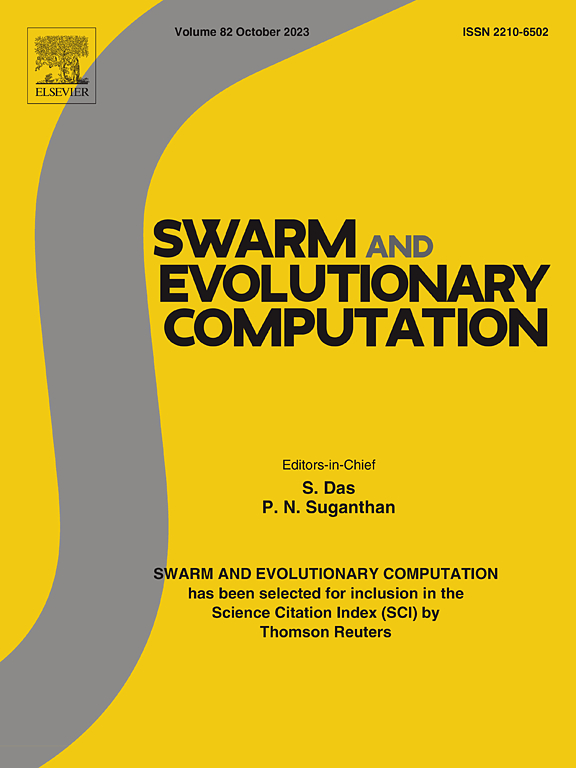Dynamic performance evaluation of evolutionary multi-objective optimization algorithms for gait cycle optimization of a 25-DOFs NAO humanoid robot
IF 8.5
1区 计算机科学
Q1 COMPUTER SCIENCE, ARTIFICIAL INTELLIGENCE
引用次数: 0
Abstract
Researchers are increasingly using optimization methods to achieve optimal dynamic performance of humanoid robots, often involving multiple conflicting objectives. Multi-objective optimization algorithms (MOAs) aim to find a Pareto front of optimal solutions, but selecting the best algorithm based on solution quality and computational efficiency remains challenging. This study comprehensively evaluates MOAs from different paradigms: swarm intelligence (CMOPSO), genetic algorithms (NSGA-II, DCNSGA-III), and decomposition-based approaches (CMOEA/D) for optimizing the gait cycle of a 25 DOF NAO humanoid robot during single support phase (SSP) and double support phase (DSP) scenarios. The algorithms’ convergence, diversity, and constraint-handling capabilities are systematically analyzed in solving the gait generation problem. The bi-objective optimization simultaneously minimizes power consumption and maximizes dynamic stability subject to eight functional constraints with 12-13 decision parameters. Through performance evaluation using running inverted generational distance (IGD) and hypervolume (HV) metrics across eleven independent runs of each algorithm, NSGA-II emerges as the most suitable algorithm, demonstrating superior convergence and solution quality, while CMOPSO shows competitive performance with faster initial convergence. DCNSGA-III exhibits moderate performance with constraint-handling difficulties, and CMOEA/D demonstrates poor convergence characteristics requiring significantly more computational resources. Two distinct knee regions emerge during both SSP and DSP, representing optimal trade-off solutions, with a systematic framework provided for practitioners to select appropriate gait parameters based on operational priorities. The running IGD metric combined with HV validation demonstrates effectiveness in providing robust algorithmic insights, enabling practitioners to select suitable algorithms for similar complex real-world optimization problems.
25- dof NAO仿人机器人步态周期优化的多目标进化优化算法动态性能评价
研究人员越来越多地使用优化方法来实现人形机器人的最优动态性能,往往涉及多个相互冲突的目标。多目标优化算法(MOAs)旨在寻找最优解的Pareto前沿,但基于解质量和计算效率选择最佳算法仍然是一个挑战。本研究综合评估了不同范式的MOAs:群体智能(CMOPSO)、遗传算法(NSGA-II、DCNSGA-III)和基于分解的方法(CMOEA/D),以优化25自由度NAO人形机器人在单支撑阶段(SSP)和双支撑阶段(DSP)场景下的步态周期。系统分析了算法在解决步态生成问题中的收敛性、多样性和约束处理能力。该双目标优化算法在满足12-13个决策参数的8个功能约束条件下,实现了功耗最小化和动态稳定性最大化。通过在每个算法的11个独立运行中使用倒代距离(IGD)和超体积(HV)指标进行性能评估,NSGA-II成为最合适的算法,具有优越的收敛性和解决方案质量,而CMOPSO具有更快的初始收敛性。DCNSGA-III表现出中等的性能,存在约束处理困难,而CMOEA/D表现出较差的收敛特性,需要更多的计算资源。在SSP和DSP过程中出现了两个不同的膝关节区域,代表了最佳的权衡解决方案,为从业者提供了基于操作优先级选择适当步态参数的系统框架。运行中的IGD度量与HV验证相结合,证明了提供稳健算法洞察力的有效性,使从业者能够为类似的复杂现实优化问题选择合适的算法。
本文章由计算机程序翻译,如有差异,请以英文原文为准。
求助全文
约1分钟内获得全文
求助全文
来源期刊

Swarm and Evolutionary Computation
COMPUTER SCIENCE, ARTIFICIAL INTELLIGENCEC-COMPUTER SCIENCE, THEORY & METHODS
CiteScore
16.00
自引率
12.00%
发文量
169
期刊介绍:
Swarm and Evolutionary Computation is a pioneering peer-reviewed journal focused on the latest research and advancements in nature-inspired intelligent computation using swarm and evolutionary algorithms. It covers theoretical, experimental, and practical aspects of these paradigms and their hybrids, promoting interdisciplinary research. The journal prioritizes the publication of high-quality, original articles that push the boundaries of evolutionary computation and swarm intelligence. Additionally, it welcomes survey papers on current topics and novel applications. Topics of interest include but are not limited to: Genetic Algorithms, and Genetic Programming, Evolution Strategies, and Evolutionary Programming, Differential Evolution, Artificial Immune Systems, Particle Swarms, Ant Colony, Bacterial Foraging, Artificial Bees, Fireflies Algorithm, Harmony Search, Artificial Life, Digital Organisms, Estimation of Distribution Algorithms, Stochastic Diffusion Search, Quantum Computing, Nano Computing, Membrane Computing, Human-centric Computing, Hybridization of Algorithms, Memetic Computing, Autonomic Computing, Self-organizing systems, Combinatorial, Discrete, Binary, Constrained, Multi-objective, Multi-modal, Dynamic, and Large-scale Optimization.
 求助内容:
求助内容: 应助结果提醒方式:
应助结果提醒方式:


